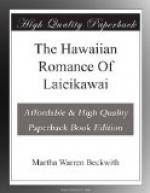There they are! There they are!!
There they are!!!
The hard wind of Kohala,
The short sharp wind of Kawaihae,
The fine mist of Waimea,
The wind playing in the cocoanut-leaves
of Kekaha,
The soft wind of Kiholo,
The calm of Kona,
The ghost-like wind of Kahaluu,
The wind in the hala-tree of Kaawaloa,
The moist wind of Kapalilua,
The whirlwind of Kau,
The mischievous wind of Hoolapa,
The dust-driven wind of Maalehu,
The smoke-laden wind of Kalauea.
There is no doubt in this enumeration an assertion of power over the forces the reciter calls by name, as a descendant of her who has transmitted to him the magic formula.
Just so the technician in fishing gear, bark-cloth making, or in canoe or house building, the two crafts specially practiced by chiefs, acquires a very minute nomenclature useful to the reciter in word debate or riddling. The classic example in Hawaiian song is the famous canoe-chant, which, in the legend of Kana, Uli uses in preparing the canoe for her grandsons’ war expedition against the ravisher of Hina (called the Polynesian Helen of Troy) and which is said to be still employed for exorcism by sorcerers (Kahuna), of whom Uli is the patron divinity. The enumeration begins thus:
It is the double canoe of Kaumaielieli,
Keakamilo the outrigger,
Halauloa the body,
Luu the part under water,
Aukuuikalani the bow;
and so on to the names of the cross stick, the lashings, the sails, the bailing cup, the rowers in order, and the seat of each, his paddle, and his “seagoing loin cloth.” There is no wordplay perceptible in this chant, but it is doubtful whether the object is to record a historical occurrence or rather to exhibit inspired craftsmanship, the process of enumeration serving as the intellectual test of an inherited gift from the gods.
Besides technical interests, the social and economic life of the people centers close attention upon the plant and animal life about them, as well as upon kinds of stone useful for working. Andrews enumerates 26 varieties of edible seaweed known to the Hawaiians. The reciters avail themselves of these well-known terms, sometimes for quick comparison, often for mere enumeration. It is interesting to see how, in the “Song of Creation,” in listing plant and animal life according to its supposed order of birth—first, shellfish, then seaweed and grasses, then fishes and forests plants, then insects, birds, reptiles—wordplay is employed in carrying on the enumeration. We read:
“The Mano (shark) was born, the
Moana was born in the sea and swam,
The Mau was born, the Maumau was
born in the sea and swam,
The Nana was born, the Mana was
born in the sea and swam.”
and so on through Nake and Make, Napa and Nala, Pala and Kala, Paka (eel) and Papa (crab) and twenty-five or thirty other pairs whose signification is in most cases lost if indeed they are not entirely fictitious. Again, 16 fish names are paired with similar names of forest plants; for example:




